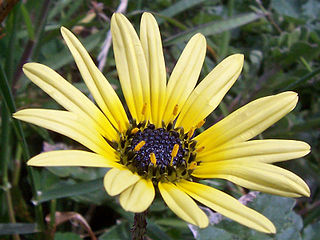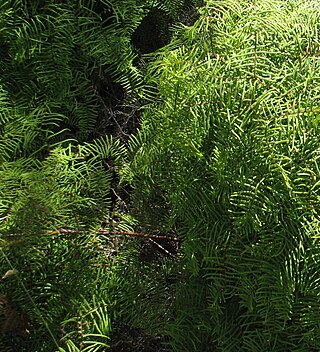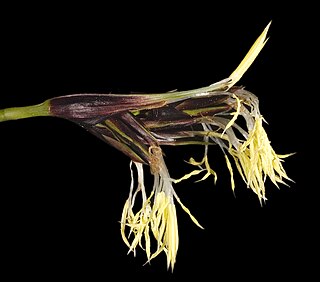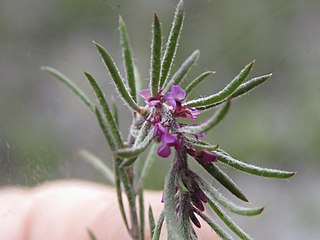
The Cyperaceae are a family of graminoid (grass-like), monocotyledonous flowering plants known as sedges. The family is large, with some 5,500 known species described in about 90 genera, the largest being the "true sedges" genus Carex with over 2,000 species.

Christian Gottfried Daniel Nees von Esenbeck was a prolific German botanist, physician, zoologist, and natural philosopher. He was a contemporary of Goethe and was born within the lifetime of Linnaeus. He described approximately 7,000 plant species. His last official act as president of the German Academy of Natural Scientists Leopoldina was to admit Charles Darwin as a member. He was the author of numerous monographs on botany and zoology. His best-known works deal with fungi.

Lycopodium is a genus of clubmosses, also known as ground pines or creeping cedars, in the family Lycopodiaceae. Two very different circumscriptions of the genus are in use. In the Pteridophyte Phylogeny Group classification of 2016, Lycopodium is one of nine genera in the subfamily Lycopodioideae, and has from nine to 15 species. In other classifications, the genus is equivalent to the whole of the subfamily, since it includes all of the other genera. More than 40 species are accepted.

Arctotheca calendula is a plant in the sunflower family commonly known as capeweed, plain treasureflower, cape dandelion, or cape marigold because it originates from the Western Cape Province in South Africa. It is also found in neighboring KwaZulu-Natal.

Margaret Rutherford Bryan Levyns was an eminent South African phytogeographer, botanist and taxonomist.

Thesium is a genus of flowering plants in the family Santalaceae. It is particularly well represented in South Africa.

Ficinia is a genus of tufted or rhizomatous sedges in the family Cyperaceae. There are around 70 recognised species in Africa, four species that occur in New Zealand and a single species Ficinia nodosa that occurs in Australia.

Arctotheca is a small genus of flowering plants in the family Asteraceae. They are annuals or perennials native to southern Africa. It is becoming an invasive weed in other parts of the world.

Gleichenia is a genus of ferns. Its closest relative is the genus Stromatopteris, restricted to New Caledonia.

Schoenus is a predominately austral genus of sedges, commonly known as bogrushes, or veldrushes in South Africa. Species of this genus occur mainly in South Africa, Australia and Southeast Asia. Others are found in scattered locations worldwide, from Europe to Asia, North Africa and the Americas. Three species occur in the peatlands of southern South America, including S. antarcticus which is found in Tierra del Fuego, where it forms a component of hyperhumid Magellanic moorland.

Paranomus is a genus of 18 species of flowering plants, commonly known as "sceptres", in the protea family. It is endemic to the Cape Floristic Region of South Africa.

Tetraria is a genus of flowering plants in the sedge family, Cyperaceae, native to Tanzania, South Africa, Borneo, Australia and New Zealand.
Muraltia flanaganii is a plant species in the milkwort family (Polygalaceae) that is endemic to rocky flats about 5 metres (16 ft) above sea level in the southwestern part of Cape Province, South Africa. It is a perennial subshrub with a height between 6 and 20 centimetres which branches mainly at its base. The plant's clustered leaves are softly-haired and have sharp tips. It produces pink flowers which are also stalkless. It has been listed by the Red List of South African Plants as endangered since 2007 due to invasive species and habitat loss. It was first written about by Margaret Levyns in 1954 in the Journal of South African Botany. It was named "minuta", the Latin word for "small", in reference to the plant's small size.

Muraltia bolusii is a plant species in the milkwort family (Polygalaceae). It is endemic to sandy coastal flatland with altitudes below 500 metres (1,600 ft) in Western Cape, South Africa. It was first described in 1954 by Margaret Levyns in the Journal of South African Botany. The Red List of South African Plants has listed it as endangered since 2007 due to habitat loss caused by nearby urban expansion, crop cultivation, and sand mining, as well as invasive species. Its population is decreasing.

Chironia is a genus of flowering plants in the family Gentianaceae, native to southern Africa. It is named after Chiron, the centaur known for his use of medicinal plants, as number of Chironia species are used in traditional medicines.
Trianoptiles is a genus of flowering plants belonging to the family Cyperaceae.

Lobostemon is a genus of flowering plants belonging to the family Boraginaceae. It is endemic to the Cape Provinces of South Africa. The majority of species are limited to the winter rainfall area of the country, from Springbok to Mossel Bay. In Afrikaans these species are known as agtdaegeneesbos, or loosely translated, bush that will heal in eight days. As this name suggests, many species have medicinal properties. This is best known from Lobostemon fruticosus, which is used for treating wounds, blood poisoning, ringworm, skin diseases and syphilis.
Myrovernix is a genus of flowering plants belonging to the family Asteraceae.
Neesenbeckia is a monotypic genus of flowering plants belonging to the family Cyperaceae. The only species is Neesenbeckia punctoria(Vahl) Levyns.














